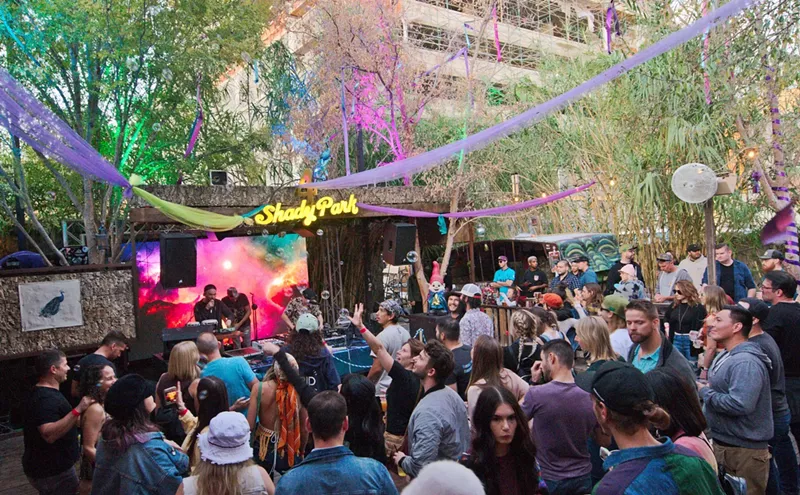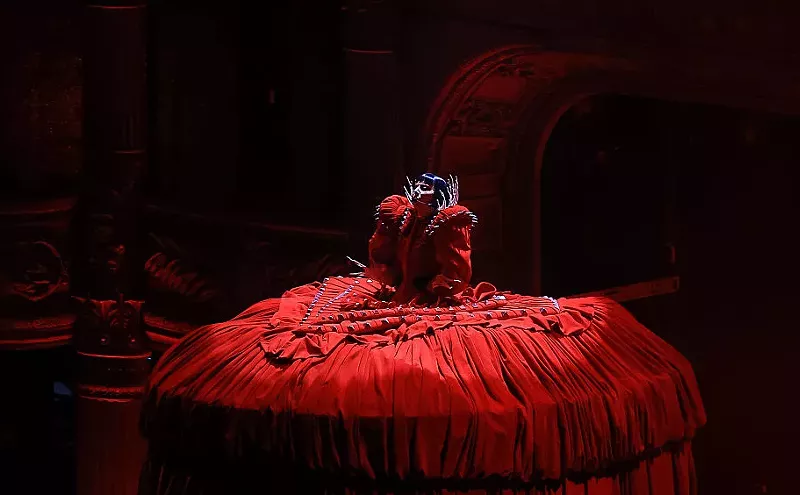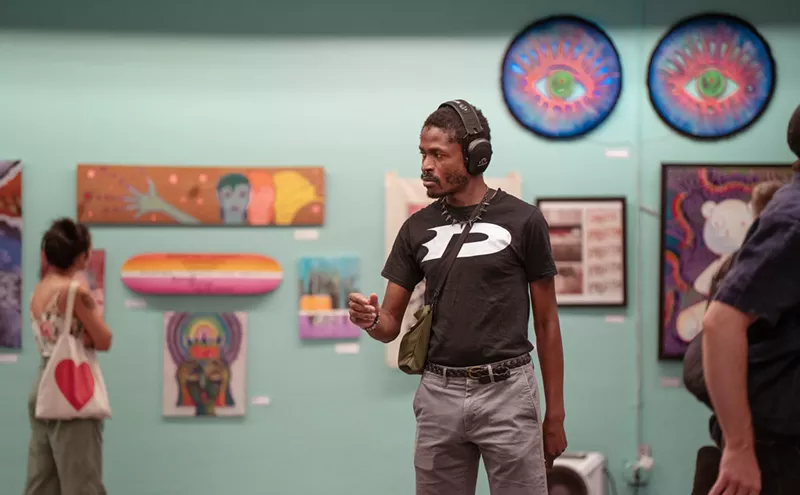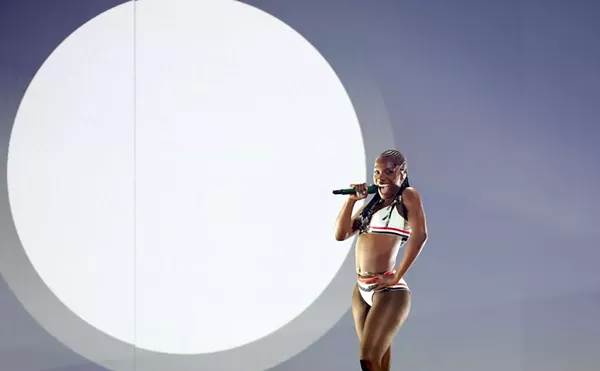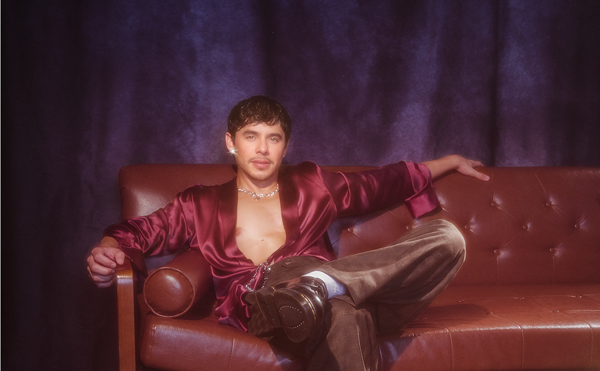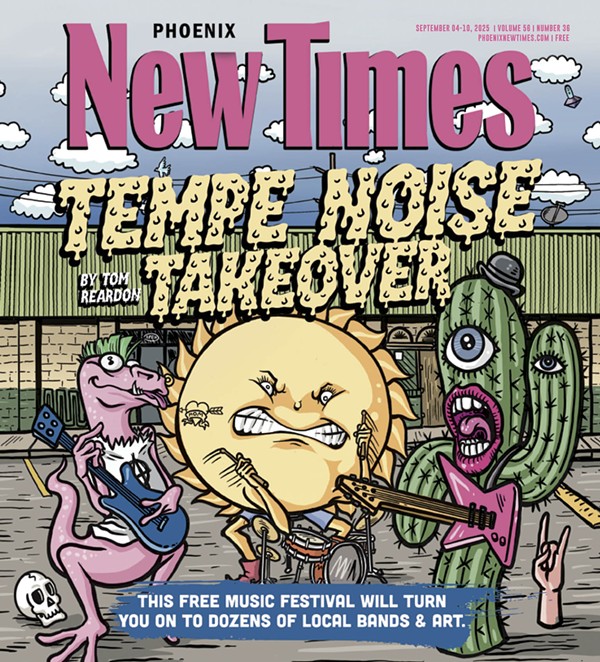In between the two events lived dreams of sailing off into faraway sunsets, of growing old together on Tim's 33-foot oceangoing vessel, Magic. "I've never sailed before," she said just before Christmas. "But can it be as hard as interviewing Hank Williams Jr.?"
Since the mid-'70s, Lovejoy had been the Valley's preeminent country music writer, a career that began when she took on the role as the infamous "Phantom Honky-Tonker" for New Times and ended as a well-respected Music City journalist. She had spent the better part of the past two decades working for country-radio powerhouse KNIX, a tenure that ended when Buck Owens and his sons, Michael and Buddy, sold the station late last year. A diminutive, dark-haired woman with cool blue eyes, Lovejoy wrote prolifically for and edited the station's popular magazine and provided regular music-oriented news spots on the air.
A Pennsylvania native, the 18-year-old Lovejoy had grown tired of working as a stitcher at a book-binding outfit when she hitched a ride with a friend to the West Coast. "I always wanted to go there," she said. As they drove through a rough-and-tumble area of Los Angeles, Lovejoy noticed a "Room for Rent" sign on an old building.
"You can just drop me off here," she told her friend, whom she never saw again. Lovejoy knocked on the building superintendent's door, but no one answered. She moved to the next door, and a large, swarthy man answered. "He was a Cuban exile," Lovejoy said. "Less than a year later, I married him."
The union lasted five rocky years, into the early '70s. The divorce depressed Lovejoy considerably, and she even considered a move back east. Then came a revelation.
"I was saved," she said, "when I discovered Kris Kristofferson."
The singer-songwriter's music buoyed Lovejoy, and instead of returning to the book bindery, she followed a new love to Phoenix. "He was a reprobate," Lovejoy said with a short laugh. "And that's what I called him. But, then again, I've always liked men with a little ornery to them, a bit of bad guy. That's probably why I was attracted to Kristofferson and how I ended up doing so well in the business -- there's more than a few of that ilk."
She would spend the next few years living and working in a small business with the Reprobate. Her affection for country music continued to grow, but the slick '70s nature of the genre didn't quite jibe with her offbeat sensibilities.
"What really got me going in a new direction was Bob Boze Bell's 'Honky Tonk Sue' illustrations," she recalled, referring to Bell's popular comic strip. "I wrote a letter to [New Times co-founder Michael] Lacey, and proposed a column -- I'd visit a bar undercover and write about it. He said to submit a sample column, and I did. And it worked."
At the time, the "urban cowboy" craze was going full-bore, and Lovejoy estimated that there were some 40 or 50 country dance clubs in the Valley.
"The Reprobate and I would visit these places and dance all night, and I would write about them," she said. "We were 'The Phantom Honky-Tonkers,' and I would tell it like it was. I looked for the seedy things."
The column proved to be very popular, and bars receiving less-than-glowing reviews from "The Phantom Honky-Tonkers" were known to put up wanted posters offering rewards for their unmasking.
When the urban-cowboy phenomenon waned, the column ended, as did the relationship with the Reprobate. Lovejoy, who also worked in accounting during the period, was approached by KNIX program director Larry Daniels, who proposed a "format news" spot. Twice a day, Lovejoy would spend 30 seconds dishing out information about goings-on behind the Pine Curtain.
"What a risk!" I'd never been near a microphone before, and suddenly I was doing daily reports. That stuff just doesn't happen," said Lovejoy of her unlikely entree into the world of broadcasting.
But the spots were a huge success, and Lovejoy found herself branching out at KNIX, writing promotional literature and profiles. By the end of the '80s, she was editing KNIX Magazine and making regular forays to Nashville. Known as a tenacious interviewer with an in-your-face style, she also dispensed advice to up-and-coming artists. Some, including superstars Brooks and Dunn and the Judds, became personal friends.
Lovejoy rode the crest of the massive "new country" boom into the mid-'90s. But in August 1996, everything changed.
"That's when I was diagnosed with breast cancer," she said. "At first, of course, I was devastated. Then I just said, 'Let's go get it.'"
Following a year of radiation and chemotherapy treatments, all vestiges of the disease seemed to have disappeared. After the Owens family sold KNIX, Lovejoy decided to address the nearly two-decade void in her personal life. She answered an ad on July 11, 1999, from the Arizona Republic's singles page:
"DEPENDABLE, ENTHUSIASTIC BOOMER Empty nest, thinking travel. Passions: NPR, Borders Books & Music, ocean sailing, cold beer, good times, brown/blue, mustache and muscles, 5'10", 180 lbs."
"Actually, I was supposed to talk to Buck Owens that night about his autobiography, but that didn't happen, so I called," Lovejoy said.
On the other end was Tim Cole. Cole, 50, had spent the last five years living on a boat on Lake Pleasant. Previously he had owned a pool business and had also been an iron worker and a carny. Presently he was working on Magic, a 33-foot Islander on which he planned to sail the Pacific. He wanted a partner to go with him.
The chemistry was right, and the couple determined they would marry and begin their storybook romance after Lovejoy returned from a family reunion in the Bay Area. While in California, Lovejoy began experiencing severe headaches.
"I knew it was bad when the pain wouldn't let me do my yoga headstands," she said. "When I got home, I called my doctor, who said to get to the hospital immediately."
After treating Lovejoy for cranial swelling -- an immediate threat to her life -- further examination revealed a massive tumor and several smaller ones on her brain. Cells from her breast cancer, which doctors thought were gone, had metastasized. The disease had moved to her liver as well. The prognosis: terminal.
"I told Tim," said Lovejoy, "'You didn't sign on for this; you should go and get on with your life.'"
"What was I going to do?" asks Cole rhetorically, shortly after his wife's death. "I'd finally found someone to love, and I was going to leave? I don't think so."
The couple was married on the patio of Lovejoy's central Phoenix townhouse. Shrouded in bougainvillea, Chinese elms and orange mimosa with a fountain in the middle, it was her favorite space.
Lovejoy had been inclined to just let the disease run its course ("I've been through this drill"), especially considering the severe nature of the cancers, but Cole persuaded Lovejoy to fight. Magic, he reminded her, was waiting for them.
Lovejoy was adamant that no radiation be used. Instead, she agreed to an alternative process at a controversial Houston clinic run by European doctors. The healing regimen involved mild, weekly chemotherapy, amino acids and the ingestion of 40 large vitamin pills daily.
When Lovejoy asked about a long-term prognosis, one of the nurses at the clinic told her, "Sweetheart, go home and live."
For a while, the system seemed to slow the spread of the cancers, and there was even some reduction in size and numbers of the tumors. Lovejoy dutifully swallowed the pills and took the treatment as Cole worked to get Magic ready, still hoping to sail off into the proverbial sunset with his bride.
The country music community heard about Lovejoy's illness, and a fund was established by Michael Owens to help defray the considerable cost of her medical bills. Nashville's best and brightest contributed liberally.
Bill Bachand, current owner of the Celebrity Theatre and the defunct Toolies Country, and a longtime friend of Lovejoy's, invited her and Cole to a Willie Nelson concert at the Celebrity last fall. After the show, Lovejoy ran into Nelson's agent. They chatted about old times, and the agent invited the couple to visit Nelson on the bus. Once aboard, the agent went up to Nelson and whispered a few words into his ear. The "Red Headed Stranger" immediately went over to Lovejoy.
"He sat down right next to me, and stared at me, gurulike -- Kristofferson always said Willie was a guru," Lovejoy remembered. "He said, 'Tell me what I can do for you.' I said, 'Will you will me your hair?' and I took off my hat so he could see my bald head. He didn't smile. He just stared into my eyes for a full minute, then he said, 'Yes.'
"It was extremely intense. Then Tim said, 'Great, I always wanted to marry a redhead.' We laughed, but Willie kept staring at me. Very powerful."
Around Christmas, Lovejoy began having trouble swallowing all her pills, and a mix-up in medication dosage put her in the hospital for a brief spell. The couple spent New Year's, as planned, in the front row and backstage of the Judds' America West reunion concert. A couple days after the show, Lovejoy decided to quit taking the medication altogether. Then she ended the chemotherapy.
"The writing was on the wall," Cole said. "The battle was unwinnable. I wasn't going to pressure her anymore -- she would do it the way she wanted.
"In the first week of January, she was still up and around. By the second week, I was her legs."
Lovejoy's final fortnight was spent contacting relatives, putting together a will, and, according to Cole, "saying goodbye a thousand times."
"She made me promise to take Magic west and go sailing," Cole says, choking back a sob. "She wouldn't let it go until I promised. So that's what I'm going to do."
Lovejoy died in the early morning hours of Tuesday, February 1. That Saturday, her husband, family and friends attended a memorial service held on her beloved patio. Sandy Lovejoy was 53 years old.



